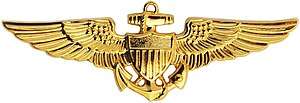Lou Lenart
Louis "Lou" Lenart (April 24, 1921 – July 20, 2015) was an American-Israeli fighter pilot.[1] His exploits during the 1948 Arab-Israeli War were documented in the 2015 film A Wing and a Prayer.[2]
Lou Lenart | |
|---|---|
| Born | Layos Lenovitz April 24, 1921 Hungary |
| Died | July 20, 2015 (age 94) Ra'anana, Israel |
| Language | English and Hebrew |
| Spouse | Rachel Nir (? – July 20, 2015) (his death) |
| Children | 1 |
Early life
Lenart was born in Hungary as Layos Lenovitz to a Jewish family in 1921, in a small village near the Czech border. His parents were farmers. When he was ten, the family immigrated to the United States, settling in the Pennsylvania mining town of Wilkes-Barre, where his parents ran a small store. As a boy, he endured antisemitic beatings.[3][4]
Marine service
After finishing high school and taking a bodybuilding course, Lenart enlisted in the United States Marine Corps. After 18 months of infantry training, he was accepted into flight school. During flight training, he was severely injured in a mid-air collision. He saw action in the Pacific Theater of World War II as an F4U Corsair pilot, serving in Battle of Okinawa and in bombing missions over Japan. He was discharged from the Marines at the end of the war with the rank of captain.[4][5]
Israeli Air Force
.png)
After learning that 14 relatives had been murdered in the Auschwitz concentration camp and attending a lecture on Zionism, Lenart decided to volunteer for Sherut Avir, the precursor to the Israeli Air Force. He took part in the clandestine smuggling of salvaged Czech-supplied warplanes to Palestine shortly before Israeli independence, flying them past the British blockade. He became a fighter pilot following the Israeli Declaration of Independence and the outbreak of the 1948 Arab-Israeli War, flying the Avia S-199 fighter plane.
On May 29, 1948, Lenart took part in Operation Pleshet, when the Israeli Air Force launched its entire fleet of four fighter aircraft in a desperate attempt to halt an Egyptian advance on Tel Aviv, in coordination with a ground counterattack. This was the first use of Israeli fighter planes in combat, and Lenart, the most experienced of the pilots, commanded the mission. The Egyptian advance was halted, partially due to the massive psychological toll the air attack took on the Egyptians, who had believed the Israelis had no planes.
Later life
After the war, Lenart participated in Operation Ezra and Nehemiah, the airlift of Iraqi Jews to Israel in the early 1950s, served as a pilot for El Al, and flew aerial mapping missions over the jungles of Central America. He produced six feature films, and was the general manager of the Los Angeles Clippers in the early 1980s. He maintained homes in Israel and Los Angeles, and upon his retirement, settled permanently in Israel.[5]
Lenart died on July 20, 2015, at his home in Ra'anana, Israel, of congestive heart failure, at the age of 94. He was survived by his wife Rachel, and his daughter and grandson.[5]
Decorations
Lenart received the following awards during his service with the U.S. Marine Corps:[6][7]

| Air Medal with one 5/16 inch star | |
| Navy Presidential Unit Citation with one star | |
| Marine Corps Good Conduct Medal | |
| American Defense Service Medal with one service star | |
| American Campaign Medal | |
| Asiatic-Pacific Campaign Medal with three bronze service stars | |
| World War II Victory Medal |
References
- "Lou Lenart dies at 94; war hero was 'the man who saved Tel Aviv'". latimes.com. Retrieved 2015-11-10.
- "Israeli Air Force, particularly its scrappy beginnings, inspires 3 films". Jewish Telegraphic Agency. Retrieved 2015-11-13.
- Los Angeles Times (July 22, 2015). "Lou Lenart dies at 94; war hero was 'the man who saved Tel Aviv'". latimes.com. Retrieved February 10, 2016.
- "'The Man Who Saved Tel Aviv' to get his due in D.C." Jewish Telegraphic Agency. Retrieved February 10, 2016.
- "Louis "Lou" Lenart". Retrieved February 10, 2016.
- http://www.timesofisrael.com/lou-lenart-pilot-who-saved-tel-aviv-dies-at-94/
- http://www.jewishvirtuallibrary.org/louis-8220-lou-8221-lenart
External links
- Lou Lenart at the Internet Movie Database